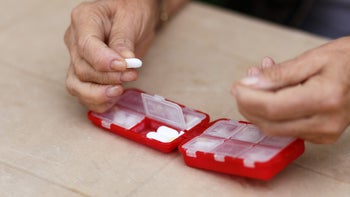
Diclofenac Dosages for Adults: Your GoodRx Guide
Key takeaways:
Diclofenac is a nonsteroidal anti-inflammatory drug (NSAID). You can take it by mouth as a capsule, tablet, or solution. You can also apply it to the skin as a gel, patch, or liquid, and it’s available as an eye drop.
Your diclofenac dosage can vary depending on your medical conditions and which form you’re taking. Your dosage may be adjusted based on how you respond to the medication.
Diclofenac is available both as a brand-name medication and a lower-cost generic. You can find generic diclofenac for less than $25 at certain pharmacies with a free GoodRx discount.
Access savings on related medications
Table of contents

Diclofenac is a nonsteroidal anti-inflammatory drug (NSAID). It’s used to treat pain and inflammation from menstrual cramps, different types of arthritis, migraines, and more. It can be taken by mouth, applied to your skin, or instilled in your eye.
In this guide, we’ll go over typical diclofenac dosages for adults. It’s important to note that these are recommendations from the manufacturers. Your healthcare provider might have you take diclofenac differently. If you have questions about your dose, speak to your pharmacist or provider.
What’s the typical diclofenac dosage for adults?
For adults, diclofenac is available in a few different forms. It goes by a few different brand names, too. You can take it by mouth as a capsule, tablet, or oral solution. You can also apply it to your skin as a topical patch, topical solution, and over-the-counter (OTC) topical gel. A prescription eye drop is available, as well.
Your diclofenac dosage will depend on why you’re taking it and which form you’re taking. For your safety, follow the instructions on your prescription or on the product packaging. You can take most diclofenac products without food. But diclofenac capsules and oral solution may work better if you take them on an empty stomach.
Keep in mind: Different forms of diclofenac aren’t interchangeable with each other. This is because they’re not absorbed by your body the same way. For example, you’ll find some forms as diclofenac sodium and others as diclofenac potassium. If you’re looking to switch between different types of diclofenac, discuss this with your healthcare provider.
Osteoarthritis
Oral and topical diclofenac dosage forms can be used to treat osteoarthritis. Depending on the product, diclofenac topical solution comes with a dropper or pump and is applied to your knees. Diclofenac gel comes with a dosing card and is applied to certain upper body joints (elbow, hand, wrist) and/or lower body joints (knee, ankle, foot).
Here are the different diclofenac dosages for osteoarthritis:
Diclofenac potassium tablets (Cataflam, Lofena): The typical dosage is 50 mg by mouth 2 to 3 times a day.
Diclofenac sodium delayed-release (DR) tablet: The typical dosage is 50 mg by mouth 2 or 3 times a day, or 75 mg twice a day.
Diclofenac sodium extended-release (ER) tablet: The typical dosage is 100 mg by mouth once daily.
Diclofenac 1.5% topical solution: The typical dosage is to apply 40 drops to each affected knee 4 times a day.
Diclofenac 2% topical solution (Pennsaid): The typical dosage is to apply 2 pumps (40 mg) to each affected knee 2 times a day.
Diclofenac 1% gel (Voltaren Arthritis Pain): You’ll apply the gel to the affected joint(s) 4 times a day. Follow the instructions for how much gel to apply each time. Don’t use more than 8 gm on any upper body joint per day, or more than 16 gm on any lower body joint per day. If you add up the amount of gel you’ve applied in total, it shouldn’t be more than 32 gm per day.
Rheumatoid arthritis
Diclofenac potassium tablets: The typical dosage is 50 mg by mouth 3 to 4 times a day.
Diclofenac sodium DR tablet: The typical dosage is 50 mg by mouth 3 to 4 times a day, or 75 mg twice a day.
Diclofenac sodium ER tablet: The typical dosage is 100 mg by mouth once daily. Your healthcare provider might raise your dose depending on your response.
Ankylosing spondylitis
Diclofenac sodium DR tablet: The typical dosage is 25 mg by mouth 4 times a day, plus an additional 25 mg at bedtime if needed.
Primary dysmenorrhea (menstrual cramps)
Diclofenac potassium tablets: The typical dosage is 50 mg by mouth 3 times a day.
Mild to moderate pain
Diclofenac potassium capsule (Zipsor): The typical dosage is 25 mg by mouth 4 times a day.
Diclofenac potassium tablets: The typical dosage is 50 mg by mouth 3 times a day.
Diclofenac epolamine patch (Flector): The typical dosage is to apply 1 patch (180 mg) to the most painful area twice a day.
Diclofenac epolamine patch (Licart): The typical dosage is to apply 1 patch (182 mg) to the most painful area once daily.
Migraine attack
Diclofenac potassium oral solution: The typical dosage is 1 packet (50 mg) mixed with 30 to 60 mL of water taken once for symptoms of a migraine attack.
Cataract surgery
Diclofenac eye drops: The typical dose is to place 1 drop into the affected eye(s) 4 times daily. Start 24 hours after surgery and continue for 2 weeks.
Corneal refractive surgery
Diclofenac eye drops: The typical dose is to place 1 to 2 drops into the affected eye(s) within 1 hour before surgery. Then, place 1 to 2 drops into the affected eye(s) within 15 minutes after surgery, and 1 to 2 drops 4 times daily for up to 3 days.
Are there any dosage adjustments for medical conditions?
Diclofenac is broken down by your liver, and your body gets rid of it through your liver and kidneys. If you have liver or kidney problems, your healthcare provider may need to lower your dosage. This is to make sure you aren’t building up too much medication in your body.
Kidney problems
There are no recommended dosage adjustments if you have kidney problems. But if you have advanced kidney disease, diclofenac may not be safe for you to take.
NSAIDs like diclofenac are known to cause damage to the kidneys and can also worsen heart failure. If you have a history of kidney or liver problems, or heart failure, let your healthcare provider know. You should also let them know if you’re taking medications for high blood pressure. They may want to monitor your blood pressure more closely during treatment with diclofenac.
Liver problems
As mentioned above, diclofenac is broken down by your liver. And while uncommon, it has also been shown to cause liver damage.
If you have liver problems, your healthcare provider might need to lower your diclofenac dosage if you’re taking it by mouth. But dosage adjustments haven’t been studied with the oral solution, so they can determine if it’s safe for you to take.
Liver damage has been mostly reported with oral forms of diclofenac. But topical diclofenac products also carry this warning. If you have liver problems, talk to your healthcare provider before starting one of these products.
What happens if you miss a dose of diclofenac?
If you forget to take your dose of diclofenac, you can take it as soon as you remember. But if it’s getting too close to the time for your next dose, it’s best to skip the missed dose.
Taking two doses too close together could lead to too much medication in your body. Never double up on your diclofenac dose. If you aren’t sure how to handle a missed dose, call your healthcare provider or pharmacist for help.
What should you do if you take too much diclofenac?
NSAIDs like diclofenac can affect many different parts of your body (such as your kidneys, liver, and gut). Taking too much diclofenac can increase the risk of serious side effects, like tears and bleeding in your stomach or gut. Kidney damage is also possible.
If you have certain medical conditions, you might be even more sensitive to taking too much diclofenac. This is also the case if you’re taking other medications that are hard on your kidneys or liver.
Taking too much diclofenac by mouth is generally a more serious problem compared to diclofenac eye drops or topical products. This is because less medication gets into your system with topical products. But depending on how much you use, you could still run into problems.
Common signs of an NSAID overdose include headache, vomiting, and nausea. Blurred vision, tiredness, and dizziness are also possible. If you or a loved one might have taken too much diclofenac, get medical attention right away or call Poison Control at 1-800-222-1222.
How to save on diclofenac
There are many ways to save on diclofenac, which is available as both a brand-name and generic medication. The diclofenac patches are only available as brand-name products. But Flector patches have an authorized generic.
GoodRx can help you save over 50% off the average retail price of the generic versions:
Diclofenac potassium tablets: $12.00
Diclofenac sodium ER tablets: $18.36
Diclofenac sodium DR tablets: $13.20
Diclofenac epolamine patch (Flector): $134.43
The bottom line
Your diclofenac dosage can depend on your medical conditions, why you’re taking it, and which form you’re taking. Your healthcare provider may adjust your dosage based on your response to the medication.
It’s important to discuss your full medical history with your healthcare provider. They can make sure you receive the correct dosage and best form of diclofenac for you. For your safety, never use more diclofenac than prescribed or as instructed on OTC products.
Why trust our experts?



References
Altaire Pharmaceuticals Inc. (2020). Diclofenac [package insert].
Altman, R., et. al. (2015). Advances in NSAID development: Evolution of diclofenac products using pharmaceutical technology. Drugs.
Assertio Therapeutics, Inc. (2019). Cambia [package insert].
Assertio Therapeutics, Inc. (2021). Zipsor [package insert].
Bryant Ranch Prepack. (2022). Diclofenac potassium [package insert].
DailyMed. (2021). Voltraren arthritis pain.
DailyMed. (2022). Diclofenac DR.
DailyMed. (2022). Diclofenac potassium.
DailyMed. (2022). Diclofenac sodium 1.5%.
DailyMed. (2022). Diclofenac sodium tablet.
DailyMed. (2022). Flector.
DailyMed. (2022). Licart.
DailyMed. (2022). Pennsaid.
MedlinePlus. (2021). Diclofenac.
National Institute of Diabetes and Digestive and Kidney Diseases. (2017). Diclofenac. LiverTox.
Petersen, B. (2009). Diclofenac epolamine (Flector) patch: Evidence for topical activity. Clinical Drug Investigation.
Proficient Rx LP. (2021). Voltaren [package insert].
Saad, J., et al. (2022). Nonsteroidal anti-inflammatory drugs toxicity. StatPearls.
Smolinske, S. C., et. al. (1990). Toxic effects of nonsteroidal anti-inflammatory drugs in overdose. An overview of recent evidence on clinical effects and dose-response relationships. Drug Safety.
SOLA Pharmaceuticals. (2022). Diclofenac sodium 1.5% [package insert].
Was this page helpful?
Related Articles
Browse medications
View AllResearch prescriptions and over-the-counter medications from A to Z, compare drug prices, and start saving.






















